For many years, Dr. Ramana Pidaparti was the only AIAA Member at the University of Georgia (UGA). But, now that undergraduate degrees in engineering are being offered, the interest in the aerospace sciences has increased proportionately to two professional Members and 16 student Members. As a result of students interested in cube satellite R&D, the Student Aerospace Initiative was begun at UGA ~six years ago and that activity has resulted in the establishment of an AIAA Student Branch at UGA!
Dr. Pidaparti has participated in recent AIAA Atlanta Council meetings and invited AIAA Atlanta Professional Members to address his, ENGR 4900 class, Aerospace Design and Optimization, to provide some real world experiences from the aerospace industry. Three volunteers have stepped forward so far, but more are needed.
- Aaron Harcrow, on aircraft design
- Jim Armor, military and civilian space industry
- Gene Fleeman, hypersonics, rocket and missile design
- You?
So, if you would like to help UGA students to learn about careers in aerospace, please contact Dr. Pidaparti via email at rmparti@uga.edu and let him know of your availability and topics.
Aaron Harcrow, AIAA Senior Member, addressed the ENGR 4900 class on April 5, 2023, to answer the question: “Is Aircraft Design Easy?”. Short answer – no. The long answer is – also no!
Aaron provided an overview of the aircraft sizing and synthesis process for which all major airframers. Boeing, Lockheed, McDonnell Douglas, Rockwell, etc., had developed proprietary computer programs to automate and facilitate the process. Most of these programs now exist only as fading memories. But, one contemporary aircraft sizing program that has endured and is publicly available is FLOPS, the FLight OPtimization System, developed at NASA Langley Research Center starting ~1980 with Arnie McCullers as principal developer. It was continuously improved until his retirement in 2011. Request it at link: https://software.nasa.gov/software/LAR-18934-1
Aaron presented a typical FLOPS sizing problem for a supersonic transport airliner. The input file is 263 lines long and the results file is 1725 eye-numbing lines!! And that was the nature of the problem: large input and output files and no graphical user interface (GUI) to ease the burden!! And, as with all computer programs, garbage in = garbage out! So, understanding the hundreds of code logic options and parameters for the multidisciplinary program that included empirical and physics-based models of aerodynamics, structures, propulsion, performance, mission sizing, field performance, noise prediction (including sonic boom!), cost analysis and wrapping this with a numerical optimization control layer WAS NOT EASY!
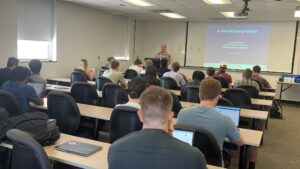

Student Aerospace Initiative | UGA College of Engineering
“The Student Aerospace Initiative engages the student body in real-world multidisciplinary aerospace projects through focusing on our three pillars of exploration, design, and community. SAI strives to make projects as interdisciplinary as possible so that every team consists of a variety of majors and provides opportunities for anyone with an interest in aerospace to participate. With these guided projects, we help prepare students for the real engineering world, where a high level of communication and teamwork are keys to success.”
Thanks to Sid Amonchomchupong, one of the student Lab Mangers for providing me a tour of the engineering building and the student labs where UAV’s/UAS’s and rockets are developed.

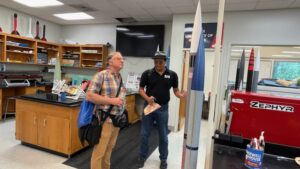
Jim Armor, Maj Gen, USAF (Ret) addressed an upper class engineering class at UGA College of Engineering on April 12, 2023, , sponsored by Prof Ramana Pidaparti, PhD.
Armor talked about his 35-year space career in the Air Force and ensuing decade in the space industry. Highlights in his AF career including an advanced degree in Electro-Optics and his time as a “technical spy” reverse engineering foreign weapon systems. After that Armor was selected as a DoD Manned Spaceflight Engineer (MSE) and began training and preparing to fly on the Space Shuttle as a Payload Special, on a NASA crewed flight. Preparation for the mission included Flight Test Engineering training in jet aircraft at Edwards AFB, Navy Dive School training in advanced water operations in Neutral Buoyancy Tanks simulating weightlessness and developing the technical interfaces and mission operations procedures for the Shuttle to fly a large, classified satellite into orbit. Sadly, 9-months prior to his planned flight the Challenger accident occurred bringing the Shuttle program to a prolonged stand-down and Armor went on to other assignments. Armor became the Director of the Global Positioning System where he was responsible for launching and operating the 30+ GPS satellite constellation. He became a global advocate for norms and standards for Position, Navigation, and Timing (PNT) systems, and presided over a dramatic increase in the global use of GPS for commercial, not just government, users including precision agriculture, networked communications, banking, scientific research, supply chain/fleet management, mapping, and local emergency management. Armor later became the Director of Signals Intelligence (SIGINT) satellite activities of the National Reconnaissance Office (NRO) and supported Allied military and intelligence operations in the Afghanistan and Gulf Wars. Armor retired from the AF as the Director of the National Security Space Office in the Pentagon with oversight of all US military and intelligence space acquisition and operations.

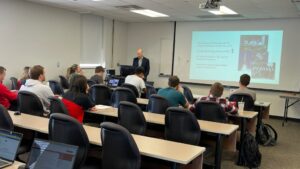
After retiring from the AF, Gen Armor’s time in the space industry included business development of several space initiatives including a new class of small military satellites. He also participated in several space startups, notably the creation of a new company, SpaceLogistics LLC, which successfully contracted to robotically dock a purpose-built mission extension vehicle (MEV) with a commercial comsat in geo-stationary orbit to extend that comsat’s operational life. Armor showed videos of the spacecraft operation and the docking mechanism. It was followed by a second MEV, both of which are operating today, and a contract with DARPA and additional commercial comsat companies for future robotic inspection, repair, upgrade, orbit adjustment and life extension missions. Armor also discussed the issues in obtaining a US government license to launch and operate a completely new mission that could be conceived globally as an anti-satellite weapon. Armor discussed his work standing up an industry association for space logistics (CONFERS, Consortium for Execution of Rendezvous and Servicing) that set norms and standards for responsible industry behavior, including the principles of legality (comply with treaties and laws), mutual consent (contract), transparency (notifications for other operators), and responsibility (safety, insurance). Armor closed with a question-and-answer period where he discussed ongoing space activities and encouraged students to enter the space career field.
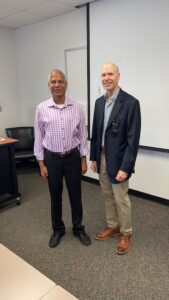
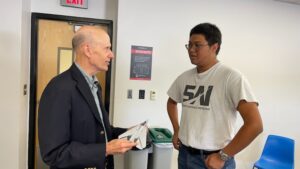
Eugene L. Fleeman, AIAA Associate Fellow and Distinguished Lecturer, has 50+ years of government, industry, academia, and consulting experience in the design and development of missile systems. Gene addressed the ENGR 4900 class via Zoom virtual meeting on March 15, 2023.
Gene, formerly a manager of missile programs at the US Air Force Research Laboratory, Rockwell International, Boeing, and Georgia Tech, is an international lecturer on missiles and the author of 200+ publications, including four textbooks. His textbooks and short courses on Missile Design, Development, and System Engineering emphasize physics-based prediction methods, for enhanced insight, speed, and accuracy to the conceptual design process. Since the year 1999 his short course has been held over 100 times in fifteen countries and five continents. Additional information is available at the web site https://sites.google.com/site/eugenefleeman/
Gene talked about his career spanning hypersonic aircraft, missile and rocket programs such as: X-15, X-24B, X-43 Hyper-X, X-51 hypersonic missile, Fast Hawk ramjet, Small Low-cost Interceptor device, AGM-130 missile, Hellfire missile and more. After retiring from Rockwell International Missile Systems Division, Gene secured a position at Georgia Tech to teach missile system design and participated in missile system studies such as: Boost Phase Interceptor, Sea Based Interceptor, Multi-mission Cruise Missile, Future Target Delivery System, GIT 1999 Design Team, Hypersonic Strike, Peacekeeper Space Launch System, Long Range Cruise Missile, Boost-Glide Strike and more. He supports STEM education programs by providing a hand-on missile design, build and fly (DBF) activity to middle and high school classes wherein students transform soda straws, paper, foam, tape and glue into missiles that are launched using compressed air. Gene emphasizes that many of the same physical principles that apply to hypersonic missile design also apply to design of a soda straw rocket!!
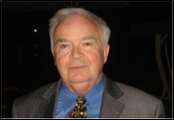
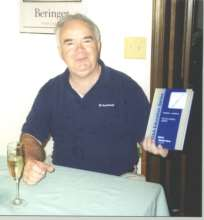

Soda Straw Rocket LaunchGene Fleeman, Author

